#voicerecognition
Explore tagged Tumblr posts
Text

PCM1840 Quad Input Microphone I2S ADC with Hardware Pin Configuration 🔊🎤🛠️
We looked up this chip in 2021, right before we got smacked with a chip shortage and couldn't get any to prototype with - but we're back in biz and respinning a prototype up. While looking up the TLV320ADC quad microphone I2S ADC, we also bumped into the PCM1840. These chips are similar (almost identical pinout) but have analog-only inputs and no I2C or SPI configuration. Yep, it's completely hardware pin bootstrapped, which makes setup much easier because you can use any I2S driver. It can act as an I2S controller (it clocks all I2S pins out) or the I2S peripheral (I2S clocks input and data is output). We whipped together a breakout to figure out how to get TDM I2S input working without dealing with the I2C setup. Looks awesome for spatial audio algorithms and voice recognition projects. You can pick up the PCM1840 ADC on DigiKey - lots are in stock!
#adafruit#PCM1840#Quad#Input#Microphone#I2S#ADC#digikey#hardwarehacking#embeddedaudio#i2scontroller#audioelectronics#spatialaudio#voicerecognition#electronicsengineering#audiodevices#prototypeboard#makersgonnamake
7 notes
·
View notes
Text

Top 5 AI Apps for Speech Recognition
AI-powered speech recognition apps enhance communication, accessibility, and automation. The top apps include Google Assistant, Apple Siri, Amazon Alexa, Microsoft Cortana, and Hound. These apps leverage deep learning for accurate voice commands, transcription, and real-time responses. They are widely used in virtual assistants, customer support, and smart devices.
#AISpeechApps#SpeechRecognition#TopAIApps#VoiceRecognition#BestAISpeechApps#AIForSpeech#VoiceTechAI#SmartSpeechAI#AITranscription#SpeechToText
0 notes
Text
Revolutionizing Productivity: The Impact of AI on Note-Taking Tools
In recent years, artificial intelligence (AI) has transformed note-taking, making it easier to organize, access, and collaborate on information. From boosting productivity to enhancing collaboration, AI note-taking tools are revolutionizing how we capture and manage knowledge. In this video, we explore the evolution of AI in note-taking, its benefits, challenges, and popular tools like Notion, Evernote, and Roam Research. Stay tuned for insights on how AI is shaping the future of productivity and information management!
youtube
#AINoteTaking#ArtificialIntelligence#ProductivityTools#NoteTaking#TechInnovation#DigitalNoteTaking#AIinEducation#SmartNotes#Evernote#NotionApp#RoamResearch#TechTrends#MachineLearning#NLP#ProductivityHacks#CollaborationTools#CloudTech#Accessibility#VoiceRecognition#DataPrivacy#FutureOfWork#Youtube
0 notes
Text

AI-Powered Speech Recognition: The Future of Radiology Reporting
Radiologists face the challenge of maintaining accuracy while managing high imaging volumes. Traditional dictation and manual reporting slow down workflows—impacting efficiency and patient care.
AI-powered speech-to-text technology is a game-changer for radiology reporting, enabling:
· Dictate reports in real-time with unmatched accuracy · Eliminate transcription errors using AI-powered NLP · Ensure compliance with FHIR & DICOM standards. · Accelerate reporting workflows for faster patient diagnosis.
The future is AI-driven, fast, and precise—with custom AI models, multilingual support, and AI-powered diagnostics on the horizon.
Ready to transform your radiology workflow? Achala Health is leading the way! Click here https://lnkd.in/gXJjCHSM to learn how we can revolutionize your radiology practice.
#AIinRadiology#VoiceAI#RadiologyInnovation#HealthcareAI#AchalaHealth#Radiology#SpeechRecognition#HealthcareInnovation#radiologypractice#voicerecognition#x-ray#mri#radiologyworkflows#EHR#HIS
0 notes
Text
Athreon delivers AI-powered and human-assisted transcription services, speech-to-text solutions, and cybersecurity solutions for healthcare, legal, corporate, and law enforcement sectors. Ensure accuracy, efficiency, and data security with our HIPAA-compliant, scalable transcription and speech recognition services designed for your needs.
#TranscriptionServices#SpeechToText#AITranscription#CybersecuritySolutions#LegalTranscription#MedicalTranscription#SecureTranscription#HIPAACompliant#VoiceRecognition#DataSecurity#BusinessSolutions#LegalTech#HealthTech#AIInnovation#LawEnforcementTech
0 notes
Text
How AI Accent Detection is Revolutionizing Communication
What is Accent Detection? Accent detection leverages AI to understand and interpret speech patterns, identifying regional or cultural accents. This technology enhances communication across diverse linguistic backgrounds, ensuring inclusivity and better customer experiences.

How Does it Work?
Speech Signal Processing: Analyzing and modifying voice data for precise interpretation.
Machine Learning Models: Training systems with diverse datasets to recognize various accents.
Real-Time Applications: Used in transcription, virtual assistants, and customer support tools.
Top Tools for Accent Detection:
Google Cloud Speech-to-Text: Supports 125+ languages with transcription services.
IBM Watson Speech-to-Text: Quick, accurate transcriptions for customer interactions.
Microsoft Azure Speech Services: Offers customizable neural voices.
Applications:
Transcription Services: Improved accuracy in multi-accent environments.
Language Learning Apps: Enhancing pronunciation and fluency.
Fraud Prevention: Voice biometrics for secure identity verification.
🚀 Learn more on our website!
#AIAccentDetection#artificial intelligence#VoiceRecognition#AccentRecognition#SpeechTechnology#SpeechRecognition
0 notes
Text
"Harnessing Voices: The Evolution of Speech Recognition"
Neuromorphic Computing Market Overview
Neuromorphic computing is a groundbreaking technology inspired by the human brain's structure and function. It aims to mimic neural processes to create more efficient, intelligent computing systems. The market for neuromorphic computing is gaining momentum, driven by growth factors such as the increasing demand for AI and machine learning, the need for energy-efficient computing, and advancements in neural network algorithms.
Read More - https://market.us/report/speech-and-voice-recognition-market/

Companies are exploring neuromorphic chips for real-time data processing, which could revolutionize industries like healthcare, robotics, and autonomous systems. However, challenges include high R&D costs, complex hardware design, and limited software compatibility.
Despite these hurdles, there are significant opportunities for new entrants, especially those focusing on niche applications or partnering with academic institutions for innovative research.
Emerging Trends
Brain-Inspired Algorithms: Neuromorphic systems are evolving to integrate algorithms that closely resemble human cognitive processes, enhancing the system's ability to learn and adapt.
Spiking Neural Networks (SNNs): Unlike traditional neural networks, SNNs process data in real-time, leading to faster, more efficient computations.
Edge Computing Integration: Neuromorphic chips are increasingly being used in edge devices, allowing for low-power, high-speed processing in applications like IoT and mobile devices.
Collaborations and Partnerships: Companies are teaming up with academic institutions to accelerate neuromorphic research and development.
Rise of Neuromorphic Sensors: These sensors mimic biological systems, enabling advanced sensory applications in robotics and healthcare.
Top Use Cases
Robotics: Neuromorphic computing enhances robots' decision-making and adaptability, making them more autonomous and efficient.
Healthcare: From brain-computer interfaces to real-time diagnostics, neuromorphic systems offer new possibilities in personalized medicine.
Autonomous Vehicles: Neuromorphic chips help vehicles process information more efficiently, improving reaction times and safety.
IoT Devices: Integrating neuromorphic processors in IoT devices leads to smarter, more responsive systems with reduced power consumption.
Smart Cities: Neuromorphic systems are being used to optimize urban infrastructure, from traffic management to energy distribution.
Major Challenges
High Development Costs: The research and development of neuromorphic systems require significant investment, which can be a barrier for smaller companies.
Complex Hardware Design: Creating hardware that mimics the human brain is incredibly complex, requiring specialized knowledge and materials.
Software Compatibility Issues: Current software ecosystems are not fully optimized for neuromorphic hardware, limiting its widespread adoption.
Limited Market Awareness: Neuromorphic computing is still a niche market, and many potential users are unaware of its benefits.
Scalability Concerns: Scaling neuromorphic systems for mass production while maintaining efficiency and performance remains a significant challenge.
Market Opportunities
Niche Applications: Companies can focus on specialized applications where neuromorphic computing offers clear advantages, such as in specific medical devices or unique industrial processes.
Collaborative Research: Partnering with academic institutions and research labs can lead to innovative breakthroughs and cost-sharing in development.
Energy-Efficient Computing: With the rising focus on sustainability, there’s a growing market for low-power, high-efficiency computing solutions.
Customizable Solutions: Offering customizable neuromorphic systems for specific industries could cater to unique needs and drive adoption.
Expanding AI Capabilities: Leveraging neuromorphic computing to enhance AI's cognitive abilities could open new avenues in various sectors, from entertainment to finance.
Conclusion
The neuromorphic computing market is still in its early stages but holds immense potential to transform multiple industries. As the technology matures, overcoming challenges like high costs and hardware complexity will be key.
Emerging trends such as brain-inspired algorithms and spiking neural networks are paving the way for innovative applications. With opportunities ranging from niche markets to collaborative research, there is plenty of room for growth. New entrants with the right focus and partnerships can carve out a significant space in this rapidly evolving field.
0 notes
Text

Mobotics - The Leader In Innovative Telecom Solutions!
Stay connected with Mobotics - the leader in innovative telecom solutions! From high-speed internet to crystal-clear voice services, we've got you covered. Experience the future of communication today!
#mobotics#telecom#Connectivity#callcenter#callcenterservices#autodialer#voicerecognition#entrepreneur
0 notes
Link
Sony, a frontrunner in haptic technology for gaming controllers, has recently unveiled a patent hinting at a revolutionary new feature: voice-based haptic feedback. This innovative concept, dubbed "Haptic Fingerprint Of User's Voice," promises to transform the way players interact with games by translating spoken words into immersive tactile sensations. Sony Patents Voice-Based A New Frontier in Immersion: Voice as the Catalyst for Haptic Feedback The core principle behind Sony's patent lies in utilizing the DualSense controller's built-in microphone to capture a player's voice, in-game dialogue, and even group conversations during multiplayer sessions. This captured audio would then be processed and transformed into unique haptic feedback patterns, creating a new layer of immersion within the gaming experience. Feeling the Words You Speak: Potential Applications While the full scope of this technology's application remains shrouded in mystery, several intriguing possibilities emerge: Enhanced Communication: Imagine shouting battle cries in a multiplayer game and feeling the intensity of your voice translated into vibrations through the controller. This could add a layer of realism and emotional connection to communication within virtual worlds. Interactive Storytelling: Voice-based haptic feedback could be integrated into the narrative design of games. For example, hearing a character whisper secrets might generate a subtle tingling sensation in the controller, while a character's booming voice could translate into a more robust vibration. Environmental Awareness: The technology could be used to translate in-game audio cues into haptic feedback. The roar of an approaching monster or the crackle of distant gunfire could be felt through the controller, enhancing a player's situational awareness. Beyond the Hype: Challenges and Considerations Sony's voice-based haptic feedback patent is undoubtedly a fascinating concept, but several challenges need to be addressed before it becomes a mainstream reality: Accuracy and Distinction: Accurately differentiating between a player's voice, in-game dialogue, and background noise will be crucial to avoid overwhelming players with unnecessary haptic feedback. Customization and User Preferences: The intensity and type of haptic feedback should be customizable to cater to individual preferences. Not everyone might want to feel every word they speak translated into vibrations. Potential for Gimmickry: It's essential to ensure this technology adds meaningful value to gameplay and avoids becoming a novelty that wears thin over time. A Pioneering Spirit: Sony's Legacy in Haptic Innovation Sony has consistently pushed the boundaries of haptic technology within its controllers. The DualSense controller, released alongside the PlayStation 5, boasts a significant leap forward compared to its predecessors. Here's a glimpse into Sony's history of haptic innovation: DualShock Controllers: The DualShock series, starting with the PlayStation 1, incorporated basic rumble technology to provide rudimentary feedback during gameplay. DualSense Controller: The DualSense, released in 2020, introduced advanced haptic feedback utilizing voice-coil actuators. This technology allows for more nuanced and precise vibrations compared to traditional rumble motors. The Road Ahead: What Does the Future Hold for Voice-Based Haptics? Sony's patent for voice-based haptic feedback represents a bold step towards a more immersive and interactive gaming experience. While this technology might still be in its early stages, it opens doors for exciting possibilities in the future of gaming. Here are some potential scenarios for the future of voice-based haptics: Integration with Artificial Intelligence: Voice-based haptic feedback could be combined with AI technology to create dynamic responses within the game world. For example, a character's reaction to your voice might be physically felt through the controller. Enhanced Accessibility Features: This technology could potentially translate in-game audio cues or dialogue into haptic feedback, offering a more inclusive gaming experience for visually impaired players. Cross-Platform Compatibility: If this technology proves successful, it could potentially be integrated into future controllers across various gaming platforms. FAQs Q: What is Sony's new patent about? A: Sony's patent, "Haptic Fingerprint Of User's Voice," aims to add voice-based haptic feedback to gaming experiences using the DualSense controller. Q: How will this technology impact gaming immersion? A: By vibrating words spoken by players, NPC dialogue, and group conversations, Sony's innovation seeks to enhance immersion levels during gameplay. Q: When can gamers expect to experience this feature? A: While specifics are yet to be revealed, Sony's ongoing commitment to innovation suggests that further developments may be announced shortly.
#DualSensecontroller#gamingtechnology#hapticfeedback#immersion#innovation#Patent#Sony#SonyPatentsVoiceBased#tactilesensations#voicerecognition
0 notes
Text
VoiceGenesis AI Review: Makes Us $635/Day. (Ram Rawat)
Welcome to my blog post VoiceGenesis AI Review. In this review, I will share user experiences, highlighting its features, Upgrades, pricing, demo, bonuses, benefits, and my evaluation.
VoiceGenesis AI is a cutting-edge software designed to revolutionize voice cloning and creation for marketing content. This innovative platform allows users to seamlessly generate natural, human-like AI voices, enhancing audience engagement, and driving conversions.
With an intuitive interface and powerful features, VoiceGenesis AI empowers businesses and individuals to personalize their brand, connect with their audience, and elevate their marketing game.
Read the full review here>>>
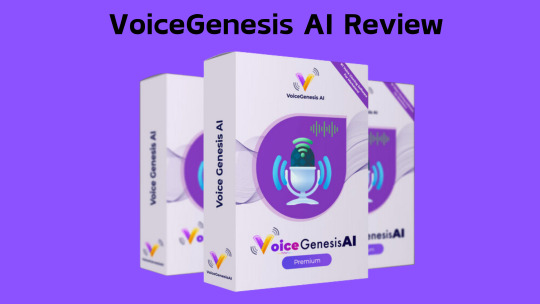
#VoiceGenesis#AIReview#ProductReview#TechReview#ArtificialIntelligence#VoiceRecognition#VoiceAssistant#TechInnovation#DigitalAssistant#VoiceTech#ProductTesting#ConsumerTech#Innovation#TechGadgets#TechNews
0 notes
Text
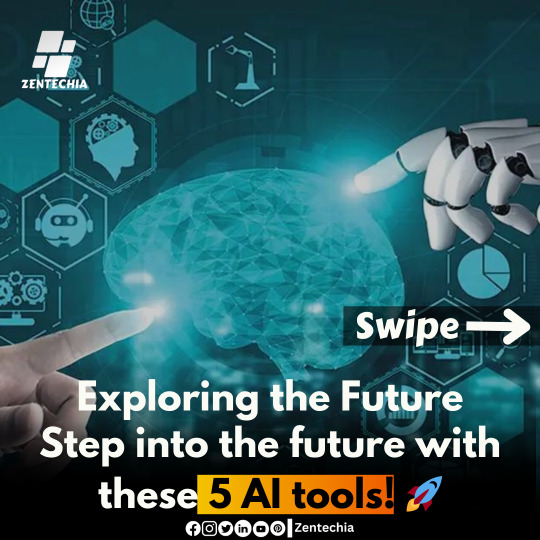

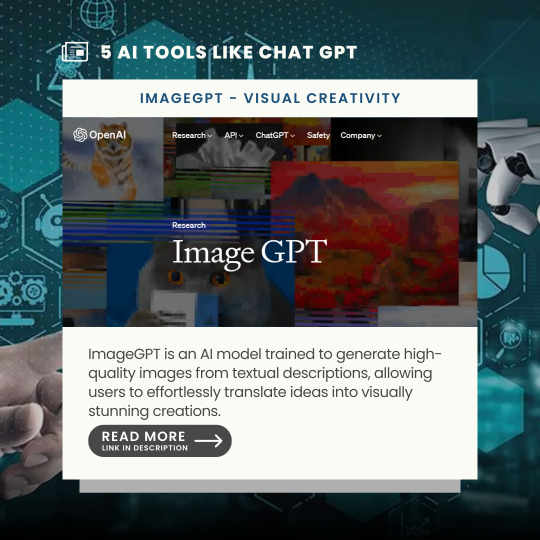
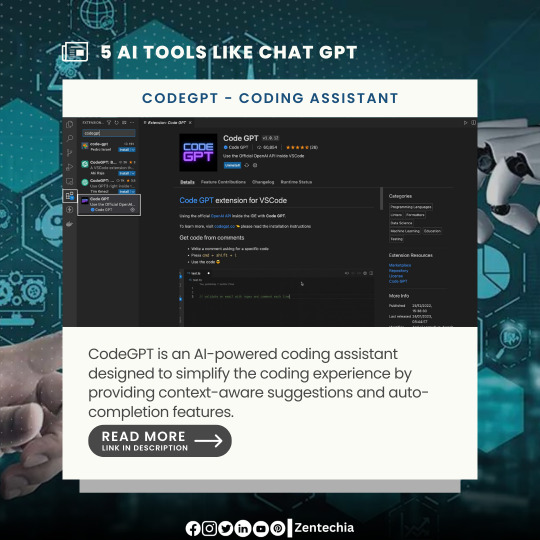
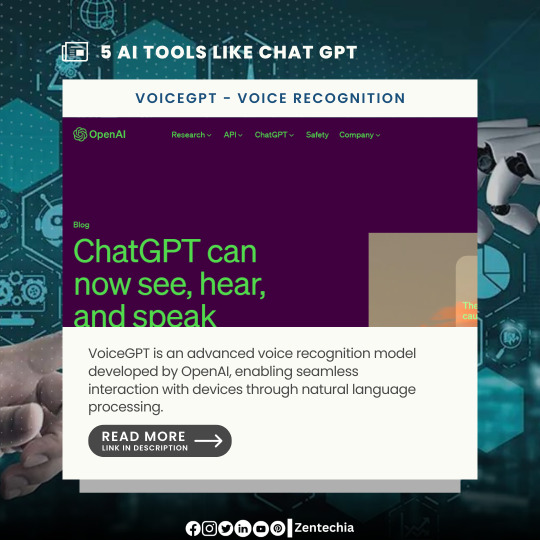
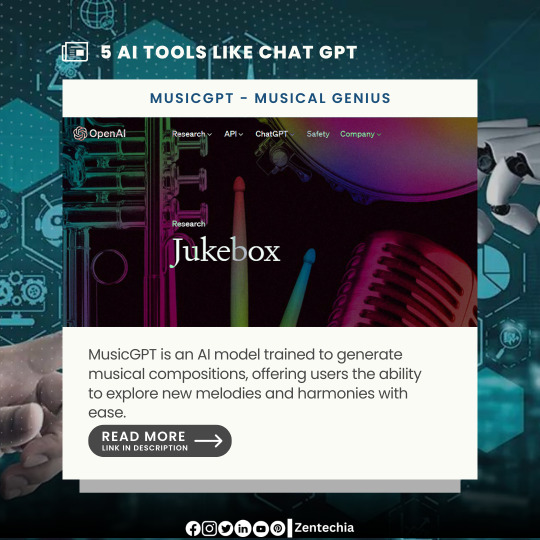
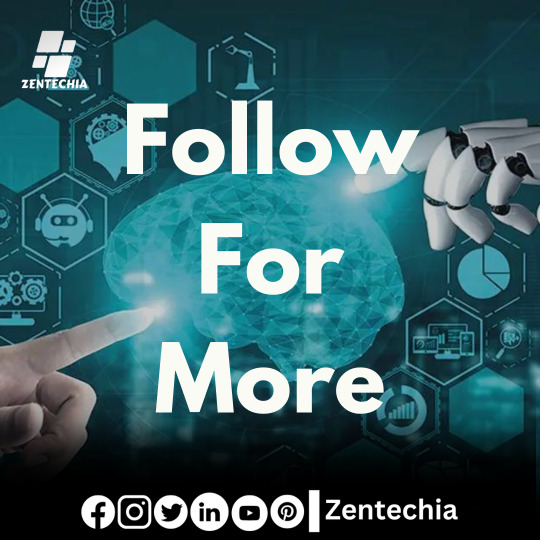
Step into the future with these 5 AI tools! 🚀
🌟 Dive into the world of AI tools and unlock endless possibilities! From engaging conversations to stunning visuals, coding assistance to voice recognition, and even musical creativity – there's no limit to what AI can do for you. 🎨✨ Embrace the future of technology and explore these innovative tools today! 💻🗣️🎵
1) Unlock the power of AI!
2) Engage audiences effortlessly.
3) Simplify coding with AI.
4) Create stunning visuals instantly.
5) Revolutionize voice recognition.
Earn Money Online: https://shorturl.at/cdinu
ChatGPT - Conversational AI
Link: https://chat.openai.com
ImageGPT - Visual Creativity
Link: https://chat.openai.com
CodeGPT - Coding Assistant
Link: https://chat.openai.com
VoiceGPT - Voice Recognition
Link: https://chat.openai.com
MusicGPT - Musical Genius
Link: https://chat.openai.com
#AI#ArtificialIntelligence#Tech#Innovation#ChatGPT#ImageGPT#CodeGPT#VoiceGPT#MusicGPT#Technology#Future#Creativity#Coding#Conversation#VoiceRecognition#MachineLearning#DeepLearning#NeuralNetworks#DigitalTransformation#TechTrends#InnovativeTech#AIinBusiness#DigitalCreativity#AIAdvancements#EmergingTech
0 notes
Text
Things To Think About When Choosing a Smart Speaker
Manufacturers must consider design, compatibility, sound quality, and other factors when creating a good smart speaker. Choosing one from the dozens of alternatives is difficult, whether people are buying one for the first time or upgrading an existing speaker. In this blog, let’s know the things when a person buys a smart speaker.
The major smart speaker producers are revising their existing product portfolios with an emphasis on giving outstanding sound quality at reasonable rates, which is expected to stimulate the market. In addition, according to a research report by Astute Analytica, the Global Smart Speaker Market is likely to grow at a compound annual growth rate (CAGR) of 18.2% over the projection period from 2023 to 2031.
Key factors when the person buying a Smart Speaker:
Sound quality:
While sound quality is vital, the genre person listens to should also be considered when selecting a smart speaker. For instance, if people like hip-hop and EDM music, then they should get a good speaker with a strong bass and a decent woofer. The sound quality of a smart speaker is also affected by how well it sounds at higher volume levels. A low-quality speaker will generate distorted sounds at high volumes. This can be prevented by selecting a smart speaker with enough power management, a broad frequency response, and a strong signal-to-noise ratio.
Style and Design:
Examine the room where the person intends to utilize the smart speaker and consider whether it will blend in with the decor. The best speaker should always match their room’s style. Consider the size, color options, and materials utilized in the speaker.
Durability is crucial as well, but it is dependent on where people intend to place their smart speakers. If they intend to take it outside, seek water and dust resistance. Of course, these features may not be important if the speaker is simply going to remain in a room all day.
Value and Pricing:
The key to purchasing a good smart speaker is extensive research. Create a budget to see how much a person can spend on it. Then, check over the speakers that are within their budget and collaborate with their favorite speaker. This will provide people with a list of suitable speakers that they can afford. Remove speakers from the list that don’t provide the audio quality or portability that they require.
Privacy safeguards:
A microphone mute switch is a basic and now common feature of any smart speaker. Though some people are too concerned about speakers capturing everything they say, most instructions must indeed be sent to the cloud for processing (after a person utters their wake word), and a tiny portion of these recordings may be utilized anonymously to develop voice assistants. Amazon Echo speaker clips have been used in a few criminal prosecutions.
Battery power or wired:
The majority of smart speakers only have wired power. A battery costs extra, and smart functionalities can consume a lot of power. Wi-Fi is extremely power-hungry, even without features like automated room adjustment or a smart home gateway.
SOURCE: Things To Think About When Choosing a Smart Speaker
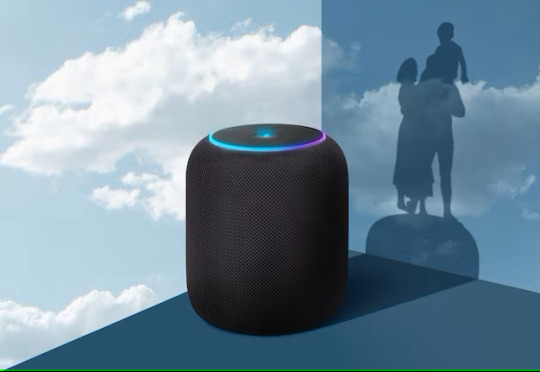
#SmartSpeaker#TechChoices#VoiceAssistant#AudioTech#SmartHomeDevices#TechGadgets#HomeAutomation#SoundQuality#VoiceRecognition#SmartTechTips#WirelessAudio#VirtualAssistant#SmartDeviceFeatures#VoiceControlled#HomeEntertainment#SmartHomeIntegration#ConnectedDevices#InternetOfThings#AudioExperience#ConsumerTech
0 notes
Text
Read all about it here : Going dotty for Prime Day – Buy One, Get One Free with code ECHODOT – CroyDivision (wordpress.com)
#EchoDot5thGen#SmartSpeaker#VoiceControl#SmartHome#MusicStreaming#Alexa#HomeAutomation#SmartTechnology#VoiceAssistant#Entertainment#SmartHomeSecurity#WiFiConnectivity#SmartDevices#HomeIntegration#VoiceRecognition#PrimeDay#OnlineShopping#DealsAndDiscounts#ExclusiveOffers#LimitedTimeOffers#PrimeMembership#Savings#ShoppingEvent#FlashSales#Electronics#HomeAppliances#Fashion#Beauty#Technology#HomeDecor
0 notes
Text
Say it, and it's done: How Medical Dictation Software is Transforming Healthcare in 2025 🚀
Did you know doctors spend 35%–50% of their time on documentation instead of patient care? 🤯 That’s hundreds of hours a year lost to typing instead of treating.
Enter medical dictation software — a game-changer that turns voice into accurate, compliant clinical text in real time.
✅ 92% speech recognition accuracy ✅ Seamless EHR integration ✅ Fully HIPAA-compliant ✅ Saves up to 2–3 hours daily per physician
Top tools in 2025 like Dragon Medical One, 3M M\Modal Fluency Direct, and Augnito aren’t just speeding up documentation — they’re restoring valuable doctor-patient time, reducing burnout, and boosting care quality.
AI, voice commands, and real-time transcription are not the future — they’re the now of modern healthcare.
🎯 Want to see how your team can benefit? Check out the full article 👉 https://wtt-solutions.com/en/healthcare
HealthcareIT #MedicalDictation #VoiceRecognition #AIinHealthcare #HealthTech #EHR #DigitalHealth #MedTech #PhysicianTools #WTTInsights #WTTSolutions
0 notes
Text
🔐 AI & Biometrics: Unlocking the Future of Security 🚀✨
🔐 AI Meets Biometrics: Shaping the Future of Security 🔍
From iris scanners to voiceprints, the rise of AI-powered biometric systems is transforming how we verify identity and secure access across industries — from law enforcement to banking.
Our latest blog dives into how Artificial Intelligence is revolutionizing biometric technologies, with real-world applications from top companies like Crossmatch, Onfido, EyeLock, and more.
💡 Key highlights:
Facial, voice, fingerprint & behavioral recognition explained
Breakthrough research funded by IARPA & DARPA
Real-world deployments in finance, government & retail
Market forecast: Biometric tech to hit $15.1B by 2025
Whether you're a tech enthusiast, security professional, or data science learner, this article is a must-read. Explore how AI is not just enhancing biometric accuracy — but redefining digital trust.
👉 Read the full blog here: https://analyticsjobs.in/ai-in-biometrics/
#AI #Biometrics #Cybersecurity #DataScience #AnalyticsJobs #ArtificialIntelligence #VoiceRecognition #FaceRecognition #BehavioralBiometrics #FutureTech #TechTrends2025
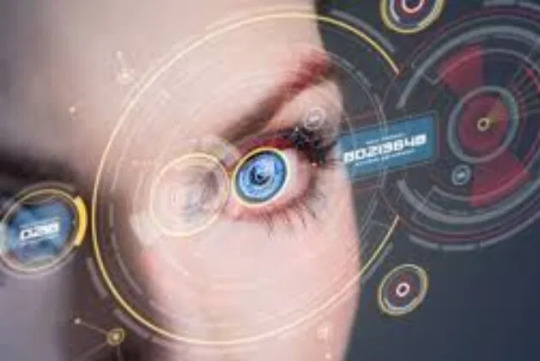
0 notes
Text
Integrating Push to Talk with Enterprise Mobile Management
Push to Talk (PTT) technology is a crucial communication solution, particularly in industries requiring instant, reliable, and secure voice communication.
PTT systems allow users to communicate with one another at the push of a button, mimicking traditional walkie-talkies but leveraging advanced digital and cellular networks for enhanced functionality. Modern PTT solutions integrate with 4G LTE and 5G networks, providing broader coverage, clearer audio quality, and reduced latency compared to conventional two-way radios. These systems often include features such as group calling, emergency alerts, GPS location tracking, and interoperability with various communication devices and platforms, making them highly versatile. Additionally, PTT applications are designed with robust security protocols, including end-to-end encryption, to protect sensitive information transmitted over the network. The integration of PTT with enterprise mobile management (EMM) platforms further enhances the manageability and scalability of these solutions, enabling IT administrators to remotely configure devices, enforce policies, and monitor usage. PTT technology is also seeing increased adoption in public safety, logistics, construction, and other sectors where coordinated real-time communication is vital. As PTT systems continue to evolve, innovations such as AI-driven voice recognition, augmented reality interfaces, and integration with Internet of Things (IoT) devices are expected to further expand their capabilities, offering new ways to streamline operations and improve response times in critical situations. #PushToTalk #PTT #RealTimeCommunication #LTE #5G #SecureCommunication #PublicSafety #EmergencyResponse #EnterpriseMobileManagement #EMM #GPS #LocationTracking #GroupCalling #Interoperability #AI #AugmentedReality #IoT #Logistics #ConstructionTech #OperationalEfficiency #VoiceRecognition #EndToEndEncryption #MobileCommunication #TechInnovation #FieldCommunication
0 notes